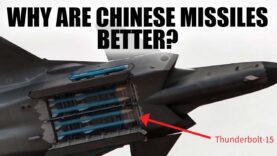Why New Chinese Missiles Outperform Those of the US
Why New Chinese Missiles Outperform Those of the US
Video Summary
In contrast, the US has been struggling to develop shorter-range hypersonic missiles, let alone ones with intercontinental range, and their anti-ship missiles are subsonic and not deployed in large numbers. The US has also been using the same radar-guided air-to-air missile, the AIM-9M, for 30 years, which is far from the technological edge of today’s weapons.
Given that the US spends three times more on its military than China, one would expect it to have an easy lead, but this does not seem to be the case. This reality highlights the need for innovation in the US military to stay ahead of the curve. According to experts, the cutting edge of missile technology currently lies in hypersonics, which are speeds greater than five times the speed of sound. Achieving and maintaining these speeds is extremely difficult due to the physical challenges involved.
The US had the early lead in hypersonic testing, but failed to follow through, while China has taken the lead. Their recent testing of a hypersonic orbital-capable weapon left the US “surprised” and sparked comparisons to the Sputnik crisis, where the Soviet Union shocked the US with its technological advantage.
The US has developed an unmanned space plane, the X-37B, which can enter orbit and re-enter autonomously at hypersonic speeds, but this is not a missile. China’s anti-ship ballistic missile, the DF-21D, is a major innovation, flying extremely fast and coming down to attack a ship from above, making it extremely difficult to defend against. The US lacks an equivalent, despite having once had the Pershing 2 ballistic missile, which was decommissioned due to the INF Treaty.
The development of the PL-15, an extremely long-range air-to-air missile, is another example of China’s technological advancements. Long-range air-to-air missiles are not new, but the PL-15 has increased range and maneuverability, and is small enough to fit internally on the J-20 fighter jet. In contrast, the US has been working on a replacement for its aging AIM-9M missile, the AIM-260 JATM, in response to the PL-15, but this is another example of the US playing catch-up.
The reasons behind the US’s lag in military technology are complex, including the constraints of treaties, a lack of necessity due to its geographical position, and complacency after the Cold War. However, the US may need to adopt a more innovative approach to stay ahead of China, rather than simply throwing more money at the problem. As SpaceX has shown, finding ways to be more efficient with existing resources can be a better path forward.
























